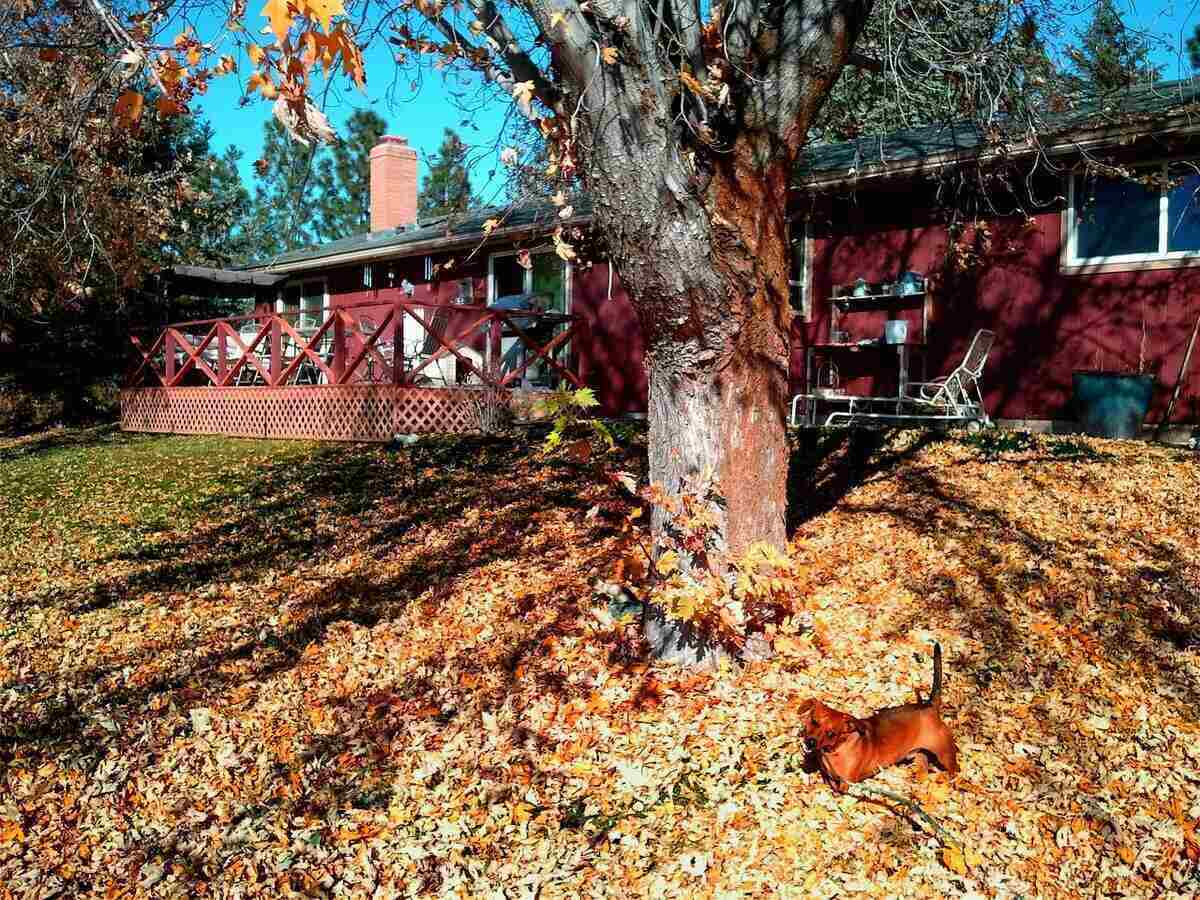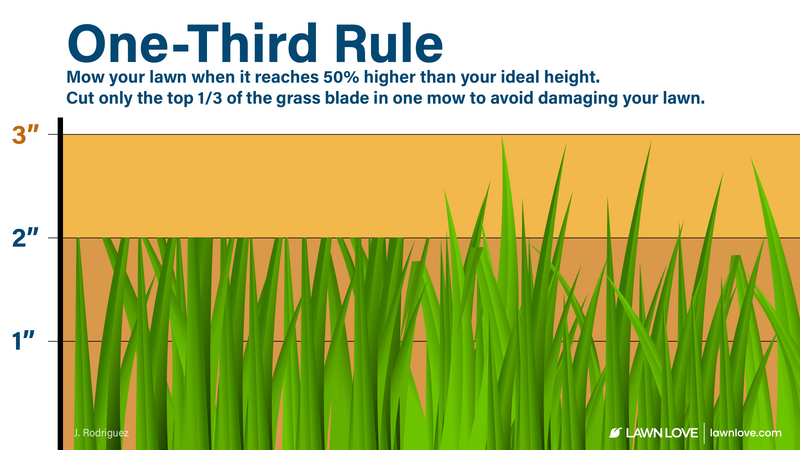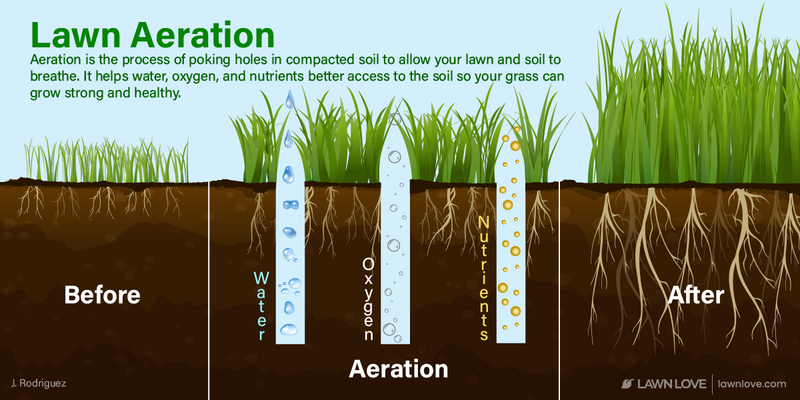
From sunset strolls in Wright Park to picnics at the Ruston Way Waterfront, it’s easy to get swept up in Tacoma’s beauty as the seasons change. But colder weather also means protecting your lawn from winter damage and preparing it for hearty growth next year.
- 1. Rake and repeat
- 2. Keep mowing until your grass stops growing
- 3. Keep watering until the ground freezes
- 4. Dethatch, if needed
- 5. Aerate for oxygen-rich soil
- 6. Overseed before the first frost
- 7. Test your soil, if needed
- 8. Control weeds with herbicide
- 9. Fertilize for healthy growth
- 10. Protect your sprinklers
- 11. Prepare your garden for winter
- Destine your lawn for success in spring
1. Rake and repeat
Tacoma’s stunning fall foliage means lots of leaves on the ground. With our rainy weather, the last thing you want is for wet leaves to build up, start stinking, and block oxygen and nutrients from reaching your grass. Rake leaves every three to four days to keep your lawn healthy.
A layer of dead leaves can cause:
- Soil compaction
- Diseases and mold
- Pest infestations
- Grass matting
- Thatch buildup
- Grass death
Raking regularly keeps your soil loose and aerated for healthy grass in spring.
Pro Tip: Don’t throw away your leaves! Use them as a free soil amendment to give your grass a nutrient boost. Mow them and leave them on your grass to decompose as a natural mulch, or compost them and then spread them over your lawn in spring to give grass a healthy layer of organic matter.
2. Keep mowing until your grass stops growing
Tacoma winters are relatively mild, so don’t stop mowing until late October to early November when temperatures dip below 50 degrees Fahrenheit. That’s when grass stops growing.
Mow once a week through September and October. Here’s how high you should mow your grass during the growing season.
| Common grass type in Tacoma | Recommended mowing height |
| Kentucky bluegrass (as part of a seed mix)* | 1.25 – 1.5 inches |
| Turf-type tall fescue | 1.5 – 3 inches |
| Perennial ryegrass | 1.5 – 2.5 inches |
| Fine fescue (like Chewings and creeping red) | 1.5 – 2.5 inches |
| Colonial bentgrass** | 0.5 – 1 inch |
* Kentucky bluegrass alone is not suited to western Washington’s soil and climate. Only certain cultivars of Kentucky bluegrass are used as part of seeding mixtures with perennial ryegrass or fine fescues.
** Colonial bentgrass requires frequent, low mowings. If planted alone, it should be mowed to a height of about 0.75 inches, or it can be mowed at a height of 1 inch if planted as part of a seed mixture. Mowing any higher will result in unhealthy thatch buildup. If mowing relaxes you or if you enjoy the look of a short, well-trimmed lawn, colonial bentgrass is perfect. Otherwise, it’s a good idea to grow another variety.
For the final mow of the season, cut your grass to either the same length or slightly shorter than usual. The Ohio State University Extension recommends mowing cool-season grasses to a height of 2 inches to prevent snow mold and matting.
Make sure not to scalp your grass by mowing too low. You don’t want to damage your grass right before it goes dormant.
Follow the one-third rule. Never mow more than one-third of your grass’s length. For example, if your grass is 3 inches high, cut no more than 1 inch off the top. Cutting more than one-third of your grass can stress it and make it more susceptible to pests and disease.

Pro Tip: Leave grass clippings on your lawn when you mow. Clippings won’t contribute to thatch and will give your grass a natural nutrient boost. According to the Washington State University Extension, a season’s worth of finely cut grass clipping equals at least one fertilizer application, and it won’t cost you a penny.
3. Keep watering until the ground freezes
Here’s a big secret to your lawn’s success: Our cool-season grass lawns grow most vigorously in spring and fall (not summer!), so it’s vital to keep watering through fall. Give your grass 1 to 1½ inches of water each week.
Stop watering after the first freeze, which normally occurs between late October and early November in Tacoma.
Be sure not to water when daytime temperatures drop below 40 degrees Fahrenheit. This can cause a sheet of ice to form overnight, which results in grass getting matted or suffocating. In April, begin watering your lawn again.
Irrigation tips:
- Water in the morning before 10 a.m. to minimize evaporation from the midday sun. Experts estimate that over 50% of our water is wasted due to evaporation, runoff, and overwatering.
- Don’t water at night, as this can invite pests and cause disease.
- Water your lawn once a week or divide watering into twice a week. Just make sure you’re giving your lawn 1 to 1½ inches of water each week.
- Water your lawn deeply and infrequently to encourage a deep, dense root system. Water should wet at least the top 4 to 12 inches of your soil. Avoid frequent, shallow waterings. Shallow waterings keep your grass roots near the soil surface, which makes your grass weaker and less drought-resistant.
4. Dethatch, if needed

If your lawn is spongy to the touch and your grass is thinning or losing its color, your lawn needs thorough dethatching.
Dethatching is the process of raking up excess thatch (the spongy brown layer of organic matter between grass blades and the soil surface) to give grass roots access to water, oxygen, sunlight, and nutrients. It’s like an exfoliating treatment for your skin.
A thin layer of thatch insulates and feeds grass roots, but too much thatch…
- Prevents the flow of oxygen and nutrients
- Makes grass more susceptible to fungal diseases like necrotic ring spot
- Acts as a breeding ground for harmful insects and microorganisms
- Makes pesticides less effective
- Increases the risk of scalping your lawn with your mower
- Makes roots grow shallowly, so grass is less drought-resistant
Dethatching …
- Increases the flow of nutrients and oxygen
- Exposes grass shoots to more sunlight
- Controls weeds
- Strengthens roots and encourages deeper growth
- Reduces susceptibility to disease, fungus, and pests
- Improves the effectiveness of fertilizer and pesticides
- Saves water and reduces runoff
When to dethatch: Dethatch your lawn in late August to mid-September, when your cool-season grass is actively growing. Dethatching is a strenuous process that can be stressful for your grass, so it’s important to give it time to recover before the winter freeze.
How to remove thatch: Vigorously rake your lawn using a manual dethatcher, electric dethatcher, power rake, or verticutter. If you’re dethatching a smaller area with a mild thatch problem, use a manual dethatcher. If you have a large lawn with a severe thatch problem, a power rake or verticutter is the way to go.
How often should I dethatch? You only need to dethatch when the thatch layer is over half an inch thick. With proper mowing, watering, and fertilization practices, you should only have to dethatch every few years.
5. Aerate for oxygen-rich soil

Many homeowners think dethatching and aeration are the same, but don’t mix them up! They fix different lawn problems: Dethatching is raking to remove thick thatch on top of the soil surface, while aerating is poking holes in your soil to alleviate soil compaction.
What is soil compaction?
Heavy foot traffic, rainy weather, home renovations, and playful pets can pack down your soil over the course of a year. That means less oxygen, water, and nutrients can reach grass roots.
How aeration works: A manual core aerator or an aeration machine pokes out 2- to 3-inch plugs of soil across your lawn to give grass roots room to breathe and the nutrients they need. Aeration loosens soil, improves drainage, saves water, and prevents thatch buildup.
When to aerate: Aerate your lawn in late September to mid-October. Like dethatching, aeration is temporarily stressful for your lawn, so it’s important to give grass time to recover before winter weather. Aerate when the soil is moist but not saturated: It’s difficult for hollow tines to penetrate dry soil.
How often to aerate: Aeration is a healthy preventative lawn care practice that keeps soil loose for dense, healthy grass growth. In Tacoma, it’s a good idea to aerate every year or every other year.
If your soil needs dethatching and aeration, always dethatch first. It’s easier to aerate soil after the thatch is removed.
Pro Tip: Fertilize your lawn one week prior to aeration to encourage grass recovery. After aeration, overseed your lawn while the soil is still open.
6. Overseed before the first frost
Does your lawn have scraggly or bare patches from summer wear and tear? Overseeding (spreading a fresh layer of seed over thin areas of your lawn) helps your cool-season grass grow evenly and densely again.
When to overseed: Spread seeds in early fall (at least 45 days before the first frost of the year) to give grass time to establish and grow deep roots before going dormant. Tacoma’s first frost usually occurs in late October to early November, so overseed in mid- to late September.
What grass should I use to overseed? For our Pacific Northwest climate, overseed with ryegrass, tall or fine fescue, or a fescue-ryegrass mix. Topdress your seeds with a light, quarter-inch layer of compost and keep seeds moist as they germinate.
7. Test your soil, if needed
Soil composition is constantly changing, and it’s important to test your soil regularly so your grass gets the right nutrients and amendments to stay healthy.
A soil test will tell you:
- Your soil’s nutrient levels and deficiencies
- Salt levels (salinity)
- pH imbalances (acidic, alkaline, or basic)
- Soil factors that might be suppressing plant growth
- The right fertilizers and soil amendments to balance your soil and increase nutrient levels
Test your soil every three to five years, or more frequently if you’re making a major lawn change (like transitioning your grass lawn to a xeriscape). Check out Washington State University’s list of recommended soil labs. Based on your soil test, you may need to amend your soil with lime or wood ash to increase the soil pH. Tacoma soil tends to be acidic.
Depending on where you live in the city, your home may be located in the Tacoma Smelter Plume, where soil has been contaminated with arsenic and lead by emissions from the former Asarco smelter. You may be eligible for free soil sampling through the Yard Program.
This testing won’t tell you what nutrients your soil needs, but rather the level of arsenic and lead in your soil. From there, you can take remedial action to clean up your yard and reduce soil toxicity.
8. Control weeds with herbicide
Cool-season weeds can be a menace to Tacoma yards. They germinate throughout the winter to give you an unpleasant spring surprise. Apply pre-emergent herbicide in September to early October to stop them from rearing their heads.
How does pre-emergent herbicide work? Pre-emergent herbicide creates a chemical barrier on the soil’s surface that prevents weeds from seeing the light of day.
In Tacoma, pre-emergent herbicide prevents the growth of:
- Crabgrass
- Barnyardgrass
- Foxtails
If weeds have already sprouted, vanquish them with post-emergent herbicide before they bloom. Spot spray persistent weeds with an herbicide that contains glyphosate or 2,4-D. Or, if you want to go the eco-friendly route, you can weed them by hand, dig them out, or apply an organic herbicide.
Common Tacoma weeds to spot spray or remove by hand:
- Yellow nutsedge
- Japanese knotweed
- Canada thistle
- Dyer’s woad
- Blueweed
- Common fennel
Be cautious when spraying glyphosate. It’s a non-selective (AKA broad spectrum) herbicide, which means it will kill any vegetation, including grass and your favorite flowers.
When to apply post-emergent herbicide: Mid-September to early November, when temperatures are still above 50 degrees Fahrenheit. You want to apply post-emergent herbicide while weeds are actively growing so they absorb it and transport it to their roots.
Pro Tip: If you’re planning to overseed your lawn, skip the pre-emergent herbicide application this season, as herbicides will kill tender grass sprouts. Instead, hand weed or spot spray weeds as they appear.
9. Fertilize for healthy growth
For western Washington, it’s best to apply fertilizer for the final time between Nov.15 and Dec. 7. A slow-release fertilizer promotes dense, green growth for long-term success.
According to Purdue University, applying fertilizer:
- Helps grass recover from damage and stress
- Keeps grass growing densely (unfertilized grass gradually loses its density)
- Prevents weed encroachment
- Protects grass’s rich green color
- Improves grass’s tolerance to heat, drought, and cold weather
- Increases disease and pest resistance
- Prepares turf for winter
- Does all this without a growth surge
What is N-P-K? N-P-K refers to the fertilizer’s ratio of nitrogen, phosphorus, and potassium (the three most essential soil nutrients). For example, a fertilizer with a ratio of 26-2-12 contains 26% nitrogen, 2% phosphorus, and 12% potassium.
What’s the best N-P-K ratio for my lawn? Consult your soil test to learn the specific ratio of nutrients your lawn needs. In general, western Washington lawns are prone to phosphorus and potassium deficiencies, so many homeowners need a fertilizer with a 3-1-2 or 6-1-4 ratio. For example, a fertilizer with a 15-5-10 or 12-4-8 ratio would be a healthy choice.
How much fertilizer should I use? Apply 1 pound of nitrogen per 1,000 square feet of lawn. If your lawn is 9,858 square feet (the average size of a Washington lawn), then you’ll need about 10 pounds of nitrogen fertilizer per application.
How often should I fertilize my lawn? Fertilize your lawn four times per year. In total, Washington lawns should receive 4 pounds of nitrogen per 1,000 square feet per year. A good schedule for western Washington is fertilizing in mid-April, mid-June, early September, and late November. The fall applications are especially important for minimizing red thread problems.
10. Protect your sprinklers
Tacoma doesn’t get much freezing winter weather, so unlike homeowners in colder states, you won’t have to blow out your sprinkler system. However, it’s still important to check off some basic to-do’s to prevent irrigation problems in spring.
How to prepare your irrigation system for winter:
- Shut off the main irrigation valve
- Drain your pipes and backflow preventer
- Insulate your backflow preventer with foam
- Store your hose in a safe, temperate place (like your garage or basement) to prevent cracking
- Cover sprinkler heads and other aboveground equipment to prevent frost damage
If a particularly bitter winter is predicted and you want to be extra careful, you can hire a professional to blow out your sprinklers. This will prevent cracks and fissures in underground piping.
11. Prepare your garden for winter
While gardens don’t tend to freeze in Tacoma, they still need to be tucked in for a chilly winter. Winterizing your garden keeps roots healthy and protects plants from disease and pests so they’re ready to grow back strong in spring.
How to winterize your garden:
- Remove dead annuals and weeds to prevent disease, matting, and pests.
- Divide perennials so they don’t compete for space and nutrients in spring.
- Add soil amendments (like compost) that will decompose over winter and give your garden healthy, nutrient-rich soil in spring.
- Trim shrubs and perennials. Remove diseased and damaged branches.
- Insulate the soil bed with 1 to 3 inches of organic mulch. A layer of mulch regulates soil temperatures, protects roots, and prevents plants from growing too early.
- Water plants a final time before daily temperatures dip below 40 degrees Fahrenheit.
Destine your lawn for success in spring
In the City of Destiny, it’s easy to fulfill your landscaping dreams with a bit of preparation and physical work. Start planning fall maintenance in late August so you can check off all your to-do’s and avoid a mid-November panic. Come spring, you can cheer on the Rainiers without worrying about patchy grass, weedy gardens, or broken sprinklers.
If you don’t know how to operate a dethatcher or don’t have time to rake your yard every three to four days, we get it. Prepping your lawn for winter can be overwhelming. You can call a team of local lawn care pros to spread fertilizer, winterize your garden, and perform any other fall task that needs to be checked off your list.
Main Photo Credit: donwhite84 | Pixabay